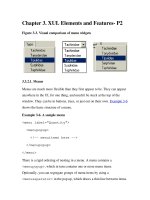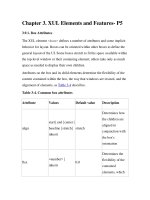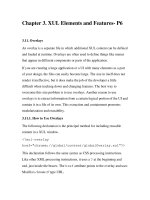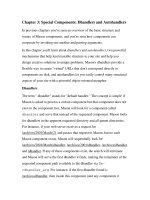Chapter 3 SQL and QBE transparencies
Bạn đang xem bản rút gọn của tài liệu. Xem và tải ngay bản đầy đủ của tài liệu tại đây (2.12 MB, 72 trang )
SQL and QBE
Transparencies
Chapter 3 - Objectives
Purpose
and importance of SQL, the main
language for querying relational databases.
How to retrieve data using the SELECT statement.
How to insert data using the INSERT statement.
How to update data using the UPDATE statement.
How to delete data using the DELETE statement.
About an alternative language for querying
relational databases called QBE.
©Pearson Education 2009
2
Structured Query Language (SQL)
Main language for relational DBMSs.
Main characteristics:
Relatively easy to learn
Non-procedural - you specify what information
you require, rather than how to get it
Essentially free-format
Consists of standard English words like
SELECT, INSERT, and UPDATE
Can be used by range of users.
©Pearson Education 2009
3
Structured Query Language (SQL)
First and, so far, only standard database
language to gain widespread acceptance.
Huge investment from both vendors and
users.
Federal Information Processing Standard
(FIPS).
Used as the basis for other standards.
ANSI and ISO standard is now the defining
language for relational databases.
©Pearson Education 2009
4
Objectives of SQL
Ideally database language should let user:
create database and table structures;
perform basic tasks like insert, update, delete;
perform both simple and complex queries.
Must perform these tasks with minimal user
effort.
Must be portable.
©Pearson Education 2009
5
Writing SQL Commands
SQL statement consists of reserved words
and user-defined words.
Reserved words are a fixed part of SQL and
must be spelt exactly as required and cannot
be split across lines.
User-defined words: made up by user and
represent names of various database objects
such as tables, columns, views.
©Pearson Education 2009
6
Literals
Literals
are constants used in SQL
statements.
All non-numeric literals must be enclosed in
single quotes (eg. ‘New York’).
All numeric literals must not be enclosed in
quotes (eg. 650.00).
©Pearson Education 2009
7
Data Manipulation – Main Statements
SELECT to query data in the database
INSERT to insert data into a table
UPDATE to update data in a table
DELETE to delete data from a table
©Pearson Education 2009
8
Simple Queries - SELECT Statement
SELECT [DISTINCT | ALL]
{* | [columnExprn [AS newName]] [,...] }
FROM TableName [alias] [, ...]
[WHERE condition]
[GROUP BY columnList] [HAVING
condition]
[ORDER BY columnList]
©Pearson Education 2009
9
SELECT Statement Key Points
FROM Specifies table(s) to be used.
WHERE
Filters rows subject to same conditions.
GROUP BY Forms groups of rows with same column
value.
HAVING
Filters groups subject to some condition.
SELECT
Specifies which columns are to appear in
output.
ORDER BY Specifies the order of the output.
Order of the clauses cannot be changed.
Only SELECT and FROM are mandatory.
©Pearson Education 2009
10
Query 3.1 All columns, all rows
List full details of all DVDs.
SELECT catalogNo, title, genre, rating
FROM DVD;
Can use * as an abbreviation for ‘all columns’:
SELECT *
FROM DVD;
©Pearson Education 2009
11
Query 3.1 All columns, all rows
©Pearson Education 2009
12
Query 3.2 Specific columns, all rows
List the catalog number, title and genre of
all DVDs.
SELECT catalogNo, title, genre
FROM DVD;
©Pearson Education 2009
13
Table 3.2 Specific Columns, All Rows
©Pearson Education 2009
14
Query 3.3 Use of DISTINCT
List all DVD genres.
SELECT genres
FROM DVD;
SELECT DISTINCT genres
FROM DVD;
©Pearson Education 2009
15
Calculated Fields
List the monthly salary for all staff, showing the
staff number, name, position and monthly
salary.
SELECT staffNo, name, position, salary/12
FROM Staff;
©Pearson Education 2009
16
Row Selection (WHERE clause)
Five basic search conditions include:
Comparison : compare the value of one
expression to the value of another.
Range: test whether value falls within a specified
range.
Set membership: test whether the value of an
expression equals one of a set of values.
Pattern match: test whether a string matches a
specified pattern.
Null: test whether a column has a unknown value.
©Pearson Education 2009
19
Query 3.5 Comparison Search Condition
List all staff with a salary greater than
$40,000.
SELECT staffNo, name, position, salary
FROM Staff
WHERE salary > 40000;
©Pearson Education 2009
20
Query 3.6 Range Search Condition
List all staff with a salary between $45,000 and
$50,000.
SELECT staffNo, name, position, salary
FROM Staff
WHERE salary >= 45000 AND salary <=
50000;
Here we use the logical operator AND in the
WHERE clause to find the rows in the Staff table
where the value in the salary column is between
$45 000 and $50 000
©Pearson Education 2009
21
Result 3.6 Range Search Condition
©Pearson Education 2009
22
Query 3.7 Set Membership
List all DVDs in the Sci-Fi or Children
genres.
SELECT catalogNo, title, genres
FROM DVD
WHERE
genre=‘Sci-Fi’
genre=‘Children’;
©Pearson Education 2009
OR
24
Query 3.7 Set Membership
There is a negated version (NOT IN).
IN does not add much to SQL’s expressive power.
Could have expressed this as:
SELECT catalogNo, title, genre
FROM DVD
WHERE genre IN (‘Sci-Fi’, ‘Children’);
IN is more efficient when set contains many
values.
©Pearson Education 2009
25
Query 3.8 Pattern Matching
List all staff whose first name is Sally.
SELECT staffNo, name, position, salary
FROM Staff
WHERE name LIKE ‘Sally%’;
©Pearson Education 2009
26
Query 3.8 Pattern Matching
SQL has two special pattern matching
symbols:
%: sequence of zero or more characters;
_ (underscore): any single character.
LIKE ‘Sally%’ means the first 5 characters
must be Sally followed by anything.
©Pearson Education 2009
27
Query 3.9 NULL Search Condition
List the rentals that have no return date
specified.
SELECT deliveryNo, DVDNo
FROM DVDRental
WHERE dateReturn IS NULL;
Have to test for null explicitly using special
keyword IS NULL (IS NOT NULL).
©Pearson Education 2009
28









